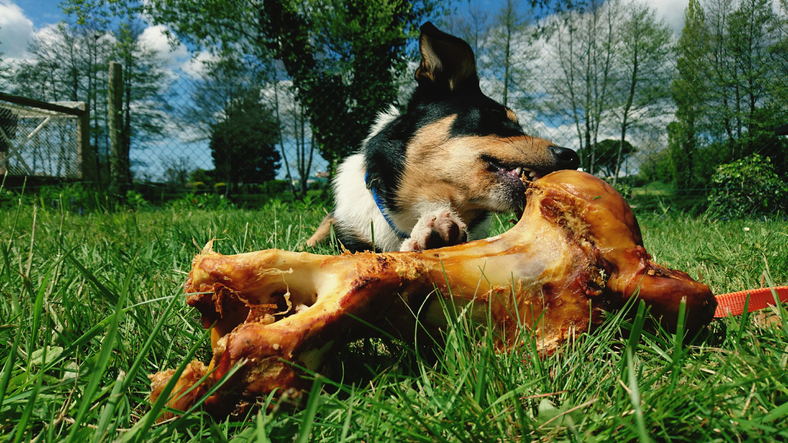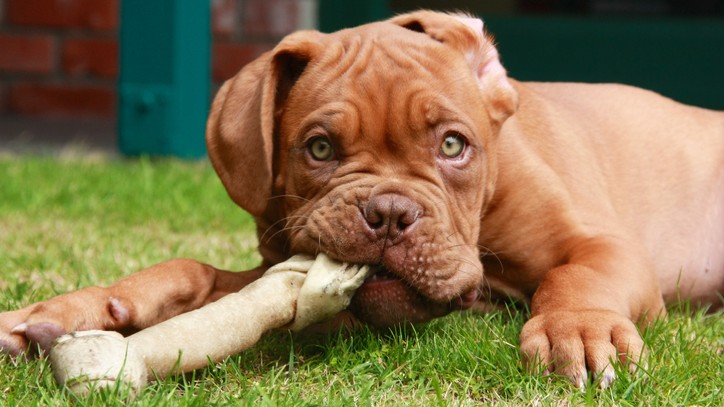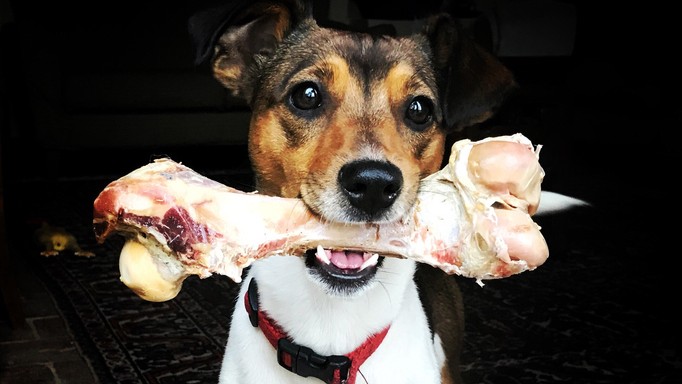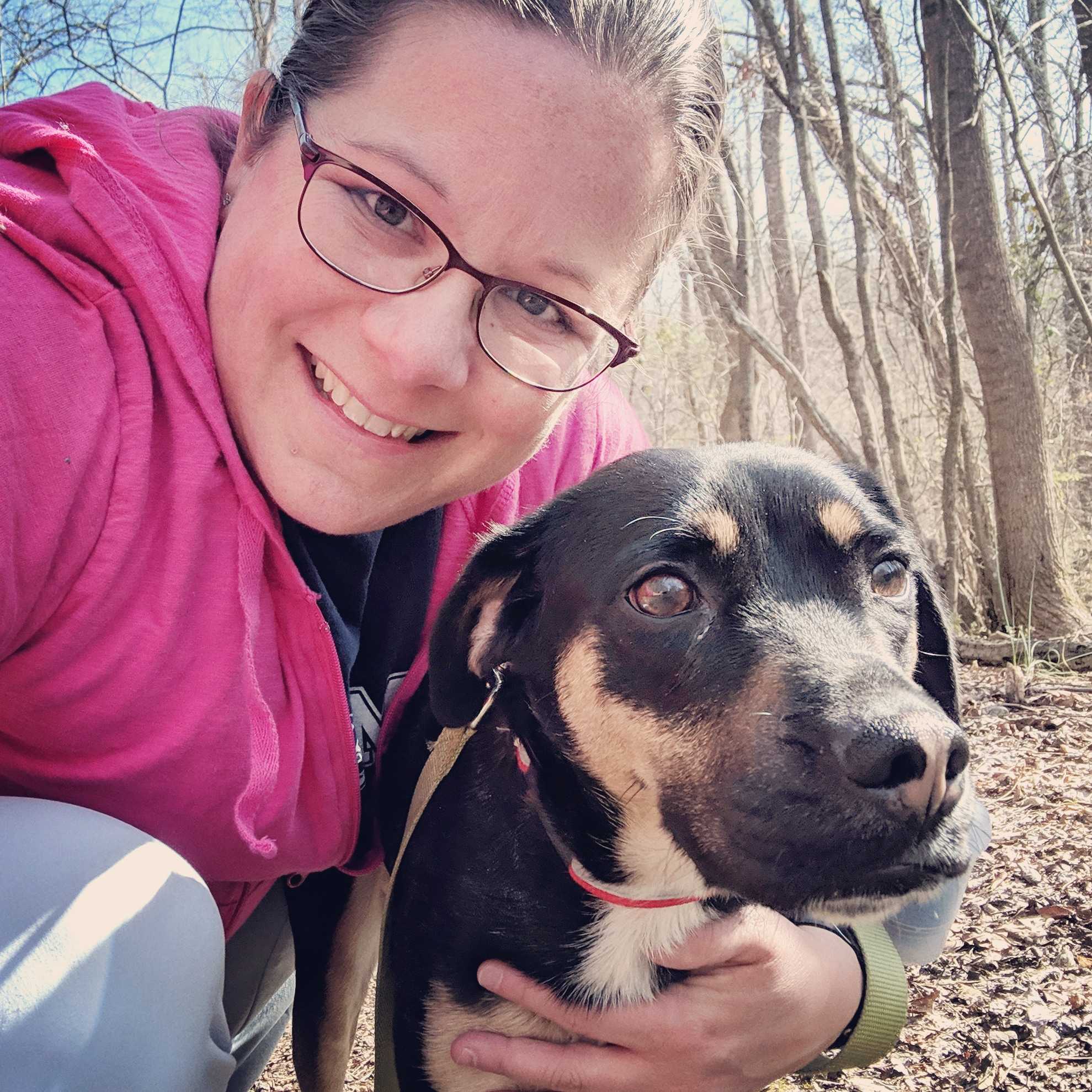Can dogs eat bones? A vet's view...
Can dogs eat bones? Feeding your pup this tasty treat may not be as harmless as you think

Can dogs eat bones? It’s a question you may have found yourself asking if you’ve ever sat around the table with your family devouring a Sunday roast dinner only to see your canine companion looking up at you with imploring eyes. Dogs love bones, but they have the potential to cause serious harm which is why it’s so important that you’re aware of the risks.
While we recommend that the bulk of your dog’s diet is made up of high-quality dog food, there are times when you may wish to reward your pup for good behavior or simply give them a treat. The longest lasting dog chews are ideal for this, but some pet parents prefer to save money by feeding their dog the bones from their own meals.
There’s no denying that bones are a nutrient-dense treat that come packed full of minerals. However, they’re also high in fat, which has the potential to result in your pup suffering from pancreatitis and they can also splinter, which can lead to choking, damage to your dog’s mouth or throat, and intestinal blockages.
To help you decide whether the advantages of bones outweigh the drawbacks, Dr Catherine Barnette is here to give her thoughts on whether bones are safe to feed your dog, the potential risks associated with both cooked and raw bones, and her tips for some lower-risk chew toys that are just as satisfying.
Is chewing a necessary behavior for dogs?
Chewing is a natural canine behavior, which means that most dogs are determined to find something to chew. Chewing alleviates boredom, while also providing an outlet for any stress or anxiety that your dog may be experiencing. Offering an appropriate chew toy is certainly better than allowing your dog to chew up your furniture or other items in your home!
Chewing can also offer medical benefits. Dental chews, including the best dental chews for dogs, can help scrape plaque and bacteria off your dog’s teeth. Chewing also increases saliva production, which helps to wash away bacteria and food debris from your dog’s mouth. Removing plaque and bacteria from your dog’s mouth slows tartar formation, delaying the development of dental disease.
While there’s certainly more to canine dental health than simply chewing on bones and treats, allowing your dog access to appropriate chew toys and longest lasting dog chews can help maintain appropriate dental health.
Get the best advice, tips and top tech for your beloved Pets
Are bones safe to chew?

While there certainly are dogs who have safely chewed bones for years, most veterinarians have seen at least one serious illness or injury caused by a bone. Marrow bones, for example, are notorious for becoming stuck on the mouths of dogs, wrapped around the entire low jaw. Removing these lodged bones requires sedation or even general anesthesia, and may be uncomfortable for the dog.
Other bones can damage the inside of the mouth, by puncturing the gums or becoming lodged between the teeth. Bones that are swallowed can become lodged within the gastrointestinal tract, requiring emergency surgical treatment fo removal.
Both cooked and raw bones have their own unique risks. While the risks differ between cooked and raw bones, neither is entirely risk-free. Due to the risks associated with bones, many veterinarians recommend alternative chew toys.
Can dogs digest bones?
A dog’s ability to digest bones or bone fragments can vary, based on a number of factors. The size of the bone, type of bone, size of your dog, and the efficacy of your dog’s chewing all play a role in whether a bone can be digested.
Chicken bones, for example, are very thin and contain large air sacs. Therefore, they can easily be chewed by most dogs. While this might sound like a good thing, it’s actually risky. Small bone splinters can become embedded in the walls of the esophagus, stomach, and intestine. In some cases, these bone fragments have even been shown to penetrate the intestinal walls, allowing the intestinal contents to leak into the abdomen. This can lead to life-threatening illness.
In contrast, a thick, heavy pork or beef bone may be far more challenging for your dog to chew into small pieces or digest. This reduces the risk of bone splinters, but increases the risk of intestinal obstruction if a large piece of bone becomes lodged in the gastrointestinal tract.
Can chewing bones be fatal?
Unfortunately, ingesting animal bones can kill your dog. Bones that become lodged in your dog’s esophagus or intestine can obstruct (block) the gastrointestinal tract. Emergency surgery may be an effective treatment, if the obstruction is diagnosed early, but this surgery is expensive and somewhat risky. An intestinal obstruction that goes undiagnosed or untreated can be fatal.
In addition to the risk of obstruction, pieces of splintered bone can penetrate the wall of the stomach or intestines, allowing intestinal contents to seep into the abdomen. This is especially common with chicken bones. Bone fragments that penetrate the intestinal walls can cause a condition known as peritonitis, which may prove fatal even with aggressive treatment.
While fatal intestinal obstructions and peritonitis caused by bones are relatively uncommon, this is a risk that can easily be eliminated by offering your dog alternative chew toys.
Health risks associated with cooked bones
Cooked bones, such as the leftovers from your family’s steak dinner, are especially dangerous. When bones are cooked, they become brittle and easily splinter into sharp fragments.
Possible risks associated with chewing cooked bones include:
- Mouth injuries
- Damage to the intestines
- Airway obstruction (caused by a bone sliding into your dog’s trachea)
- Intestinal obstruction
- Pancreatitis (caused by the ingestion of rich or fatty food)
Processed bones, which are available in many pet stores, pose similar risks. These bones are cooked to kill bacteria, which can make them brittle. Although they are cooked, contamination with food-borne bacteria (such as E. coli and Salmonella) has been reported in numerous cases. These infections can cause serious illness in dogs.
If your dog ingests a cooked or processed bone, monitor them closely for vomiting, diarrhea, or other signs of illness. Contact your veterinarian if your dog begins to appear unwell or if you have any questions or concerns.
Raw bones are not necessarily a safer option
Some people consider raw bones to be a healthier alternative to cooked bones. While raw bones are less likely to splinter, they are not without risk.
Risks associated with chewing raw bones include:
- Tooth fractures
- Other oral injuries
- Airway obstruction
- Intestinal obstruction
- Pancreatitis
- Food-borne infection (caused by E. coli, Salmonella, or other food-borne bacteria)
In reality, there’s no such thing as a ‘safe’ bone for dogs to chew.

Lower-risk chew toys
Dogs have a biological need to chew. It’s up to us, as responsible pet owners, to find a safe outlet for those chewing desires. There are several features to consider in your search for a chew toy, including both the hardness and size of the chew toy.
A good chew toy should be relatively soft, to minimize the risk of tooth damage. Nylon or rubber toys are safer than hard plastic. If you wouldn’t feel comfortable thumping the toy against your kneecap, it’s probably too hard for your dog’s teeth.
Make sure that the toy is too large for your dog to swallow, and sturdy enough that it will not break into smaller pieces when chewed. Choosing an appropriately sized toy will minimize the risk of airway and intestinal obstruction, which can occur if your dog swallows a toy or a piece of a toy.
Veterinarians frequently recommend a number of common chew toys. Learning how to use Kong toys is well worth it as these are a popular option; they can be filled with food or treats, providing lots of mental stimulation for dogs. Nylabones and other soft rubber chew toys are an excellent choice.
Even rawhides can be an appropriate chew toy, as long as you supervise your dog carefully. Take the rawhide away if it becomes small enough to be swallowed. A rawhide chew can obstruct the esophagus if it is swallowed.
To help prevent dental disease, consider looking for chew toys approved by the Veterinary Oral Health Council. While the VOHC seal is not a guarantee of safety, products bearing this seal have been shown to be effective at decreasing dental plaque and tartar. You will still need to evaluate the safety of these products and supervise your dog, but at least you can be assured that these products will offer dental benefits.
The goal: maximize benefits while reducing risk
As you can see, the question “can dogs eat bones?” does not have a simple answer. Yes, dogs can technically eat bones, and many do so with minimal problems. The reality, however, is that eating bones presents significant risks to a dog and these risks can be reduced with some consideration.
The use of appropriate chew toys can provide many of the same benefits as bones, with a lower risk to your dog’s overall health. This is especially true if you select your dog’s chew toys carefully, and only offer chew toys to your dog under close supervision.
For more information on what foods are safe for your canine companion to consume, be sure to check out our guide to what human food can dogs eat? And are rawhide bones good for dogs and can dogs have fish skins?
Dr. Barnette is a graduate of the University of Florida, where she received both her B.S. in Zoology and her Doctor of Veterinary Medicine (DVM). She has 15 years of clinical experience as a small animal veterinarian, treating dogs, cats, and occasional exotic patients. She now works as a freelance veterinary writer, creating educational content for veterinarians, veterinary team members, and dedicated pet owners. Dr. Barnette lives in southwest Florida with her husband and daughter (plus two cats, a dog, and a rescued dove!) and enjoys kayaking, biking, and hiking. Learn more about Dr. Barnette at www.linkedin.com/in/catherinebarnette.

